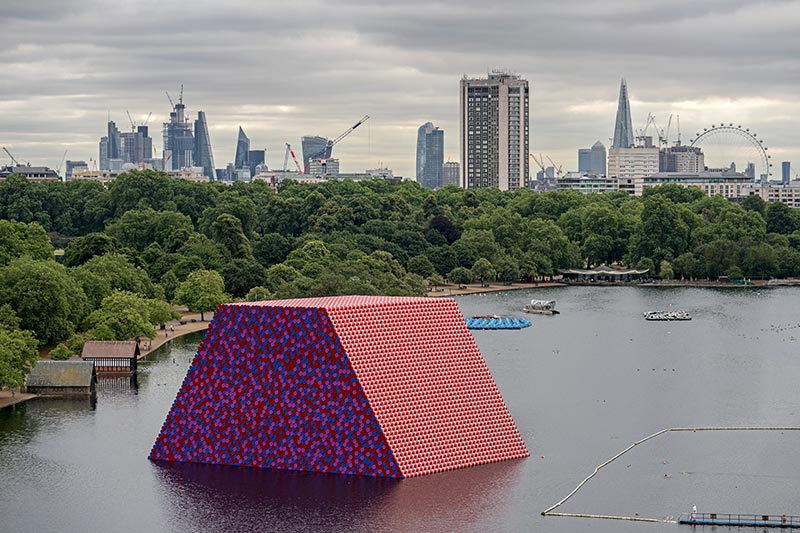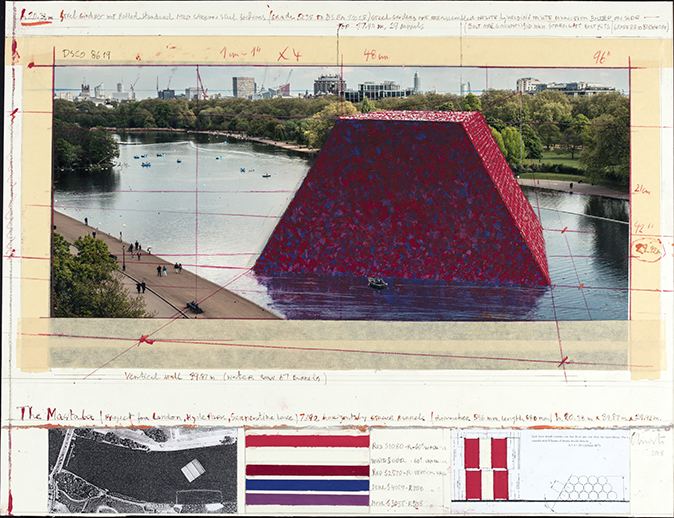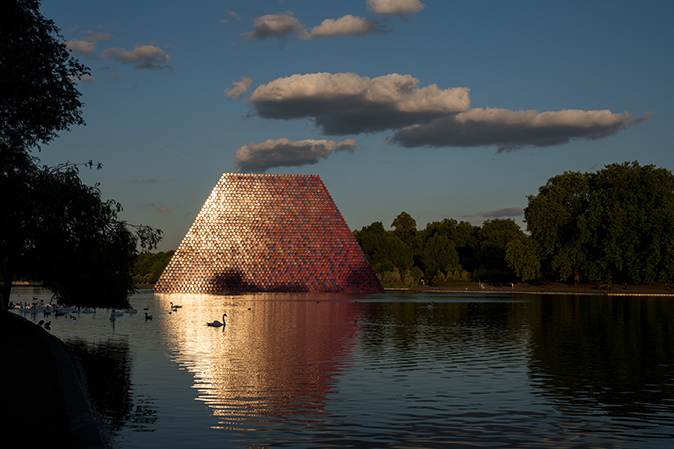In Focus: The story behind the London Mastaba, the 7,506 barrels currently floating on The Serpentine in central London
The artistic husband-and-wife team of Christo and Jeanne-Claude have been making headlines across the world for decades. Since Jeanne-Claude's death Christo is carrying on alone – and his latest piece is a striking new landmark in the centre of London, as Lilias Wigan explains.

Distinguished artists Christo and his late wife Jeanne-Claude (both born on June 13, 1935) are best known for their collaborations involving the technique of wrapping. Together, they have wrapped on a monumental scale: a section of Australian coastline, The Pont Neuf in Paris and the Reichstag in Berlin.
More recently, the wrapped Floating Piers on Italy’s Lake Iseo prompted an invitation from the Serpentine Galleries to build on the water in London’s Hyde Park. They had been searching for a suitable site since the late 1960s. The result, now afloat and entirely self-funded by Christo, draws on another aspect of their work: building with barrels.
Christo – born Christo Javacheff, but always known as Christo – had a Macedonian mother who instilled in him the importance of visual and performance art from a young age, encouraging him to paint and build models with her artist friends. He studied at the National Academy of Art in Sofia until he left Bulgaria, which had come under Communist power, in 1956, and he remained without citizenship in any country for 17 years.
During that time, he began making sculptures using existing objects: bottles, cans and barrels. With a lack of funds, inexpensive canvas and fabrics were his chosen materials for covering the containers and he would then combine lacquer and sand to make robust, structural forms. He found these objects transitory, ‘to do with escaping, carrying things, bundles or going home’ and often reflecting his own nomadic lifestyle as a political refugee.

Christo began making columns of stacked barrels for his first solo exhibition at Galerie Haro Lauhus, Cologne in 1961. In one of the exhibition rooms was a wall of barrels, which he built because he had been living in Germany the year the construction of the Berlin Wall began. One newspaper captioned an image of it as ‘The Most Controversial Exhibition Cologne Has Ever Seen.’ The work of Christo and Jeanne-Claude is inherently provocative in this way. For The Iron Curtain – Wall of Barrels, Rue Visconti, Paris (1961-62), they worked illegally for eight hours one evening to make an ‘art barricade’—a blockage wall of 89 barrels that stopped traffic. The Algerian War of Independence was rife at the time and Paris was violent, with official barricades blocking the streets.
Barrel walls led to three dimensional arrangements. The London Mastaba is one of them. A colossal floating structure on the Serpentine Lake, it is made from 7,506 fabricated painted barrels, weighs 600 tonnes, is stacked 20m high and is 40m long.
The newly fabricated barrels burst with saturated colour - painted in hues of red, white, blue and mauve; their silky lacquer glows in sunlight. The structure can be seen from various vantage points, but the best way to understand its immensity is to row a boat around the base and experience the differences in weightiness, light and shadow from each side.
Exquisite houses, the beauty of Nature, and how to get the most from your life, straight to your inbox.
Viewed front-on, it blocks out the full proportions and appears like one of the flat blockade walls, its surface reminiscent of strangely enlarged pixilation or pointillist painting. Even the surrounding water is deluged with reflected ripples of colour. This is the first of the barrel structures to interact with a landscape and it has dramatically transformed the view, sparking divided opinion.

The Arabic term mastaba can be traced back to ancient Mesopotamia (now Iraq), where it referred to the benches built in front of houses on the streets of the earliest recorded urban civilization. The form of the mastaba is characterised by a trapezoid shape that Christo and Jean-Claude have enlarged to titanic scale. Their work breaks the boundaries of particular genres — installation, sculpture, model, architecture — and pushes imagination in momentous ways outside the gallery context.
Yet Christo isn’t finished. He plans to extend his and his wife’s ambitious legacy with his largest mastaba yet, in Abu Dhabi – and using an incredible 410,000 barrels.
The London Mastaba will float on the Serpentine Lake from June 19 to September 9, 2018. Entry is free. It coincides with an exhibition at the Serpentine Galleries of Christo and Jeanne-Claude's work, including sculptures, drawings, collages and photographs spanning over 60 years.